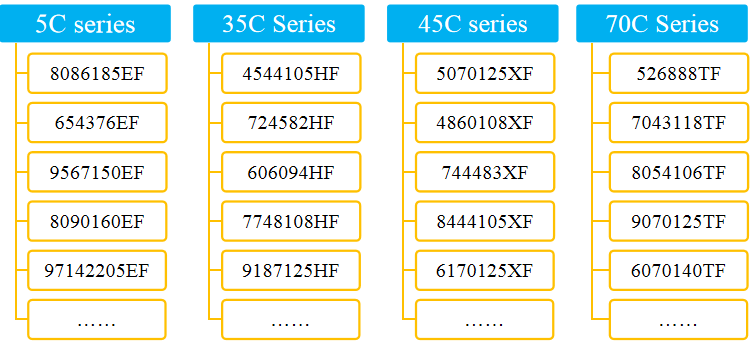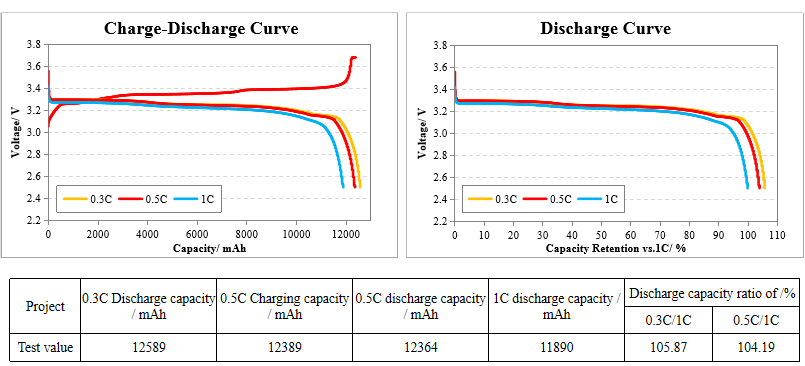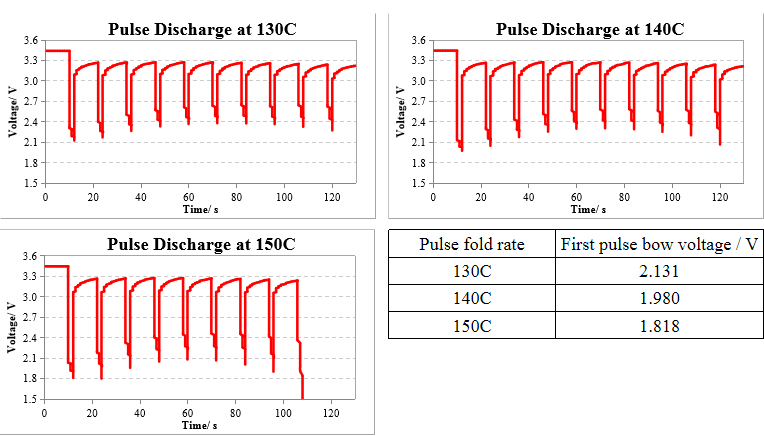
Ampxell LiFePO4 Battery
The LiFePO4 (Lithium Iron Phosphate)
battery, also known as the LFP battery, is a type of rechargeable battery. It
is regarded as the safest lithium battery currently available on the market.
Designed to be compact, lightweight, and highly energy-dense, it delivers
exceptional performance.
With a cycle life reaching thousands of
cycles, AMPXELL's LiFePO4 batteries offer high-powered cell performance
suitable for a wide range of lithium-ion applications. These batteries deliver
more power and extended longevity compared to traditional alternatives.
Features of AMPXELL LiFePO4 Battery
Performance of LiFePO4 Battery

Application Field
Performance of 5C Series (Example:
8086185EF-12Ah)
|
No |
FB8086185EF -12Ah |
|||
|
1 |
Basic performance |
Specification |
Thickness * Width * Length (mm) |
8.2*86.0*183.0 |
|
2 |
Weight (g) |
259.6 |
||
|
3 |
Internal resistance to ACR (m Ω) |
0.95 |
||
|
4 |
1C |
capacity (mAh) |
11891 |
|
|
5 |
Midpoint voltage (V) |
3.224 |
||
|
6 |
Electric performance |
3C |
Midpoint voltage (V) |
3.122 |
|
7 |
The 3C/1C capacity retention rate is (%) |
95.1 |
||
|
8 |
5C |
Midpoint voltage (V) |
2.991 |
|
|
9 |
The 5C/1C capacity retention rate is (%) |
91.4 |
||
|
10 |
Normal temperature @1Year |
The 0.5C capacity retention rate is (%) |
90.12 |
|
|
11 |
0.5C capacity recovery rate (%) |
94.03 |
||
|
12 |
Expansion rate (%) |
2.59 |
||
|
13 |
65°C@7days |
The 0.5C capacity retention rate is (%) |
95.15 |
|
|
14 |
0.5C capacity recovery rate (%) |
98.06 |
||
|
15 |
Expansion rate (%) |
4.48 |
||
|
16 |
80°C@24hours |
The 0.5C capacity retention rate is (%) |
98.81 |
|
|
17 |
0.5C capacity recovery rate (%) |
96.96 |
||
|
18 |
Expansion rate (%) |
2.87 |
||
2.2 Charge and Discharge performance
Test Method: At a room temperature,
charge at 0.5C constant current to 3.68V, with a cut-off current of 0.05C.
Discharge at rates of 0.3C, 0.5C, and 1C to 2.5V.

2.3 Rate performance at room Temperature
Test Method: At room temperature,
charging @0.5C constant current to 3.68V, with a cut-off current of 0.05C.
Discharge at 1C, 2C, 3C, and 5C constant current to 2.5V.

|
No. |
Discharge capacity / mAh |
Capacity retention rate is vs.1C/% |
Midpoint voltage / V |
|
1C |
11891 |
100.0 |
3.224 |
|
2C |
11340 |
95.3 |
3.188 |
|
3C |
11312 |
95.1 |
3.122 |
|
5C |
10873 |
91.4 |
2.991 |
2.4.1 Room Temperature Storage (1
Year)
Test Method: Charge at 0.5C constant
current to 3.68V, cut-off current 0.05C. Store at room temperature for 1 year,
then discharge at 0.5C to 2.0V. Repeat the cycle 3 times and record internal
resistance, thickness, and capacity before and after storage.
|
Normal |
Before constant temperature storage |
After constant temperature storage |
Calculate |
||||||||
|
Core |
Internal |
capacity |
Core |
Internal |
1st capacity |
3rd capacity |
Expansion |
Internal |
Capacity |
Capacity |
|
|
8.19 |
0.94 |
12358 |
8.40 |
0.99 |
11137 |
11620 |
2.59 |
5.75 |
90.12 |
94.03 |
|
|
65°C |
Before high temperature storage |
After high temperature storage |
Calculate |
||||||||
|
Thickness |
Internal |
Capacity |
Thickness |
Internal |
1st capacity / mAh |
3rd capacity |
Expansion |
Internal |
Capacity |
Capacity |
|
|
8.15 |
0.92 |
12346 |
8.52 |
0.96 |
11747 |
12106 |
4.48 |
4.69 |
95.15 |
98.06 |
|
Test method: Similar to the 65°C test, but stored at 80°C ± 2°C for
24 hours.
|
80°C |
Before high temperature storage |
After high temperature storage |
Calculate |
||||||||
|
Thickness |
Internal |
Capacity |
Thickness |
Internal |
1st |
3rd capacity |
Expansion |
Internal |
Capacity |
Capacity |
|
|
8.17 |
0.97 |
12346 |
8.40 |
1.04 |
11971 |
12199 |
2.87 |
7.02 |
96.96 |
98.81 |
|
3.1 Battery performance (Example: 4544105HF-1.6Ah)
|
No |
FB4544105HF -1.6Ah |
|||
|
1 |
Basic performance |
Specification |
Thickness * Width * Length (mm) |
4.5*43.5*106.0 |
|
2 |
Weight (g) |
39.7 |
||
|
3 |
Internal resistance to ACR (m Ω) |
3.0 |
||
|
4 |
1C |
capacity (mAh) |
1650.1 |
|
|
5 |
Midpoint voltage (V) |
3.216 |
||
|
6 |
Electric performance |
30C |
Midpoint voltage (V) |
2.819 |
|
7 |
The 30C/1C capacity retention rate is (%) |
98.6 |
||
|
8 |
35C |
Midpoint voltage (V) |
2.796 |
|
|
9 |
The 35C/1C capacity retention rate is (%) |
97.2 |
||
|
10 |
40C |
Midpoint voltage (V) |
2.668 |
|
|
11 |
The 40C/1C capacity retention rate is (%) |
96.0 |
||
|
12 |
Low temperature discharge of vs room temperature |
-20°C&25C (%) |
91.6 |
|
|
13 |
Pulsed voltage @1s |
120C(V ) |
2.243 |
|
|
14 |
150C(V) |
2.053 |
||
|
15 |
180C(V ) |
1.884 |
||
|
16 |
Pulsed voltage @2s |
130C(V ) |
2.131 |
|
|
17 |
140C(V) |
1.980 |
||
|
18 |
150C(V) |
1.818 |
||
|
19 |
Normal temperature @1Y |
The 0.5C capacity retention rate is (%) |
89.97 |
|
|
20 |
0.5C capacity recovery rate (%) |
92.01 |
||
|
21 |
Expansion rate (%) |
2.63 |
||
|
22 |
65°C@7days |
The 0.5C capacity retention rate is (%) |
94.35 |
|
|
23 |
0.5C capacity recovery rate (%) |
97.58 |
||
|
24 |
Expansion rate (%) |
4.59 |
||
|
25 |
80°C@24hours |
The 0.5C capacity retention rate is (%) |
96.56 |
|
|
26 |
0.5C capacity recovery rate (%) |
97.92 |
||
|
27 |
Expansion rate (%) |
2.91 |
||
3.2 Charge and discharge performance
Test method: At constant temperature, the constant pressure of 0.5C to 3.68V, cut-off current of 0.05C; is discharged at 0.3C, 0.5C, 1C to 2.5V. respectively

|
No. |
0.3C Discharge |
0.5C Charging |
0.5C discharge |
1C discharge |
Discharge |
|
|
0.3C/1C |
0.5C/1C |
|||||
|
Test value |
1664 |
1660 |
1659 |
1645 |
101.15 |
100.85 |
3.3 Rate performance at room temperature

|
Project |
Discharge capacity / mAh |
Capacity retention rate is vs.1C/% |
Median voltage / V |
|
1C |
1645 |
100.0 |
3.216 |
|
30C |
1623 |
98.6 |
2.819 |
|
35C |
1600 |
97.2 |
2.796 |
|
40C |
1580 |
96.0 |
2.688 |
3.4 Rate performance at low temperature
Test method: At room temperature, CC @ 0.5C,then CV to 3.68V, cut-off @ 0.05C; Store cells at -20 °C ± 2 °C for 4hours, then CC@ 25C to 1.5V.

|
Project |
Normal temperature |
-20 °C Discharge Capacity |
-20 °C discharge |
-20 °C for discharge |
-20 °C / room temperature |
|
Test value |
1645 |
1508 |
1.857 |
2.560 |
91.6 |
3.5.1 Pulse discharge performance for 1s
Test method: At room temperature, CC @ 0.5C and CV to 3.68V, at room temperature, cycle 10 times at 120C, 150C, 180C each time is 1s..

3.5.2 Pulse discharge performance for
2seconds
Test method: At room temperature, CC charge @ 0.5C, then CV 3.68V; at room temperature, discharge @ 130C, 140C, 150C for 2s till 130 times.

3.6.1 room temperature storage for 1
year
Test method: CC Charge @0.5C, then CV to 3.68V, cut-off @ 0.05C; then store the cells at room temperature for 1Year. Then 0.5C discharge to 2.0V; then 0.5C charge, cycle 3 times, record the internal resistance, thickness and capacity before and after the storage.
|
Normal |
Before storage at room temperature |
After constant temperature storage |
Calculate |
||||||||
|
Thickness |
Internal |
Capacity |
Thickness |
Internal |
1st |
3rd capacity |
Expansion |
Internal resistance |
Capacity retention |
Capacity recovery |
|
|
4.41 |
2.89 |
1659 |
4.53 |
3.15 |
1476 |
1526 |
2.63 |
8.84 |
88.97 |
92.01 |
|
3.6.2 High Temperature storage @ 65 °C
for 7days
|
65°C |
Before high temperature storage |
After high temperature storage |
Calculate |
||||||||
|
Thickness / mm |
Internal |
Capacity |
Thickness |
Internal |
1st |
3rd capacity |
Expansion |
Internal resistance |
Capacity retention |
Capacity recovery |
|
|
4.49 |
2.98 |
1649 |
4.70 |
3.12 |
1556 |
1609 |
4.59 |
4.74 |
94.35 |
97.58 |
|
3.6.3 High Temperature storage @80
°C for 24hours
Test method: After CC charging @0.5C, then CV to 3.68V, cut-off @
0.05C; then store cells in the 80°C±2°C for 24hours, discharging 4-8h at room
temperature @ 0.5C to 2.0V; CC charge@ 0.5C, cycling 3 times to record the
internal resistance, thickness and capacity before and after core storage.
|
80°C |
Before high temperature storage |
After high temperature storage |
Calculate |
||||||||
|
Thickness / mm |
Internal resistance, |
Capacity |
Thickness |
Internal |
1st |
3rd capacity |
Expansion |
Internal resistance |
Capacity |
Capacity |
|
|
4.47 |
2.91 |
1657 |
4.60 |
3.12 |
1600 |
1623 |
2.91 |
7.23 |
96.56 |
97.92 |
|
Why LiFePO4 Batteries are Ideal for
Commercial Applications
The energy storage market has experienced
rapid growth, and lithium-ion batteries have emerged as superior to other
chemistries, including nickel-cadmium (NiCd) and lead-acid. Lithium iron
phosphate (LiFePO4) batteries are particularly well-suited for industrial use
due to their safety, environmental friendliness, and long lifespan.
Key Advantages of LiFePO4 Batteries:
Why Choose Us?
Ampxell was founded in 2005 as a cutting-edge
technology company specializing in the research, development, and production of
LiPo batteries, LiFePO4 batteries, and power management systems. With decades
of growth, Ampxell has become one of the leading manufacturers of high C-rate
and high-capacity batteries. Our proprietary brand, Ampxell, is recognized both
domestically and internationally.
With extensive expertise in battery
technology, Ampxell has developed a wide range of products that are widely used
and highly regarded in various fields, including unmanned aerial systems, R/C
hobbies, consumer electronics, medical instruments, portable power systems,
electronic devices, and military applications. Backed by our independent
battery and electronics R&D team, we provide top-tier OEM/ODM services to
our customers and have earned certifications as a trusted supplier from many
well-known domestic and international companies.
To date, our sales network covers all regions of China and extends to most parts of Asia, Europe, the Americas, Australia, and certain regions of Africa. We are actively seeking global distributors to further enhance our ability to deliver efficient distribution and exceptional after-sales service to our customers.
